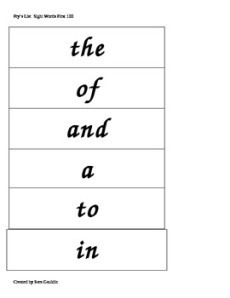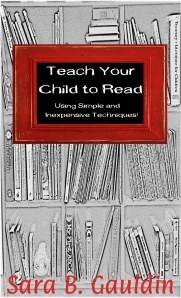Teach Your Child to Read! – I can read “the”, “and”, “I”, and many more words!
Up until this point the entire focus on reading has been on listening to stories and transitioning from rote letter knowledge to authentic words. It is now time to integrate another element that is essential to becoming a strong reader; sight word recognition. During the late eighties and early nineties, schools threw out the entire phonics concept in favor of a technique known as whole language. Essentially students were asked to read by memorizing the way words looked. Of course, this meant a huge about of memorization with no deeper understanding of the mechanics of the words. Children who had excellent memories and would have gone on to become a great reader anyway flourished, while others quickly fell flat. Children needed the letter and sound strategies that have been discussed to be able to break down an unfamiliar word to read it. It is impossible to memorize and have free recall of literally millions of words in the English language, but it is completely reasonable to expect children to learn letter sounds and blending techniques for a small set of letters.
Out of this bleak era of all or nothing education, a shining particle of truth was exposed; children needed to learn to recognize specific words automatically in order to gain reading fluency. These common words are known as sight words. As an adult, we read using sight words intuitively. It is not something that we have to think of consciously in order to do. This is not the case for a beginning reader. Imagine if you had to sound out every single word in this chapter to interpret what the words said. If this process was slow and tedious would you have any idea what you just read when you reached this point in the text? The answer is probably no. For children to gain a true understanding of what they read, they need to be able to read smoothly, with expression and at a reasonable pace. After all, the entire point of reading is to take meaning from printed text. If children are spending the whole time they are reading tediously breaking each word into its letter sounds instead of enjoying a great story, the appeal will be short lived.
By learning to recognize words that are used frequently automatically, children can dramatically speed up the reading process. This will allow for better processing of meaning from the text.
There are basically two commonly accepted commercial lists of sight words that are recommended for young children to learn to recognize automatically. One is the DOLCH list, and the other is the Fry’s list. I use the Fry’s list in my classroom, so I will focus on that resource here.
There are six hundred words in the Fry’s list. They are grouped into six 100 word sections that are arranged in order of increasing difficulty. Beginning readers should be able to handle four or five words per week. By the end of first grade or the beginning of second grade most children can handle up to ten words weekly. Begin with the words from the first one hundred list. When that list is mastered the child is ready for the second hundred. Learning to recognize sight words is a slow process that requires quite a bit of practice for some children.
It is worth mentioning that children who have demonstrated extreme difficulty with learning to read using phonics, such as those with an auditory processing disorder are sometimes instructed using a program that is purely focused on sight word acquisition.
A complete list of the Fry’s words can be downloaded here!
http://www.cantonschools.org/content/pdf_files/la_frylist.pdf
Try this!

Start by making flash cards that feature the words! Note cards work well for this purpose. For simplicity or time conservation I have created lists that can be cut apart and used instantly here:
The First 100 Wordshttp://www.teacherspayteachers.com/Product/Frys-List-First-100-Flashcards-Wordwall-Cards-410803
The Second 100 Wordshttp://www.teacherspayteachers.com/Product/Frys-List-Second-100-Flashcards-Wordwall-Cards-471894
The Third 100 Wordshttp://www.teacherspayteachers.com/Product/Frys-List-Third-100-Flashcards-Wordwall-Cards-471904
The Fourth 100 Wordshttp://www.teacherspayteachers.com/Product/Frys-List-Fourth-100-Flashcards-Wordwall-Cards-472139
The Fifth 100 Wordshttp://www.teacherspayteachers.com/Product/Frys-List-Fifth-100-Flashcards-Wordwall-Cards-472148
The Sixth 100 Wordshttp://www.teacherspayteachers.com/Product/Frys-List-Sixth-100-Flashcards-Wordwall-Cards-472151
Our school’s reading specialist advocates printing the words using standard handwriting rules on brightly-colored sentence strips, and then cutting the words out so that the shape of the word’s structure is visible and obvious. This strategy is useful for visual learners.
Play ball! Post a word card on the refrigerator. Decide on a sport to use for the game; I use soccer, baseball, football, volleyball, snowball fights and leaf raking, and then jumping in the imagined pile of leaves in my classroom. Have the child shout each letter of the word while making the motion of the activity such as throwing, kicking, raking, etc. Aim the imaginary volley at the posted word. At the end of the spelling session shout the word and end with a big throw, kick or jump for flourish.
Spell the words while forming the letter shapes with the foam sword. Say the word with the final jab.
A child working with a partner or a parent can take turns writing the word on one another’s hand with a finger or a cotton swab.
Post words in a hallway or walkway, either on the wall, or on large pieces of paper on the floor. Have your child to say the words each time they travel through the area as the secret password for passage.
Use flashcards as flashcards; have your child read them as you flip through the stack of cards. This strategy is useful for quick reviews and occasional larger reviews of words the child has already been introduced to.
Play hot potato with flash cards. Pass the card back and forth for a set amount of time. Use a tooth brush timer, a song on the radio, a cook timer, a television commercial or some other event that ends itself naturally as the deciding factor in who must read the hot potato word. It is okay for the adult to read the word when they are caught by the timer.
Go fishing! This activity takes some preparation. I have found fish shapes on Google’s images in the past. I created sight word labels and adorned my fish using labels, then had them laminated. I placed a paper clip on each fish and placed them on a paper pond with the word side facing down. My students used a magnet that I attached to a string and stick to catch the fish. If they read the word correctly they could “keep the fish” in their pile. If they were incorrect they had to “throw the fish back.” A much simpler version of this game would be to add paper clips to the word cards you use and allow your child to fish with a magnet attached to a string.
Related articles
Dibels Conversion Chart For Fountas And Pinnell (tricceldengi.wordpress.com)
Literacy is Gaining Ground With The Release of DIBELS Standards, eReflect Announces (virtual-strategy.com)
Letter sounds click together to reach a major milestone (thenewkindergarten.wordpress.com)
Launching the Way to Reading Comprehension Infographic (elearninginfographics.com)
Fluency Presentation (britanygriffin.wordpress.com)
Book review: Dyslexia, Fluency, and the Brain (williamsandmintod.wordpress.com)
How AudioBooks Help Raise Reading Scores Infographic (elearninginfographics.com)
Reading Fluency For Kids Five Strategies (lyrics2learn.wordpress.com)
A Confluence of Fluency in Orlando (accidentvictimsalliance.com)






